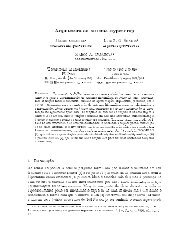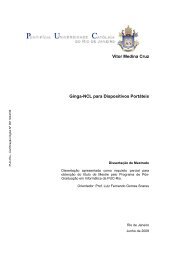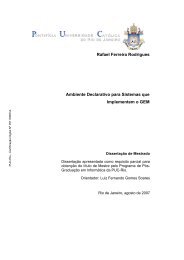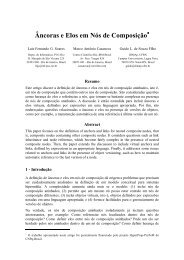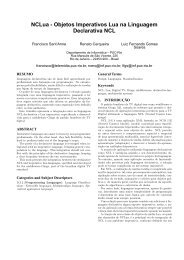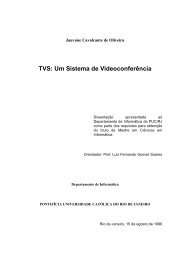Ginga-NCL: Declarative Middleware for Multimedia IPTV Services
Ginga-NCL: Declarative Middleware for Multimedia IPTV Services
Ginga-NCL: Declarative Middleware for Multimedia IPTV Services
You also want an ePaper? Increase the reach of your titles
YUMPU automatically turns print PDFs into web optimized ePapers that Google loves.
80<br />
There are several<br />
commercial<br />
implementations of<br />
<strong>Ginga</strong>-<strong>NCL</strong> <strong>for</strong><br />
terrestrial set-top<br />
boxes. Some of<br />
them also offer<br />
support to <strong>IPTV</strong><br />
plat<strong>for</strong>ms. Some<br />
commercial set-top<br />
boxes plan to offer<br />
<strong>Ginga</strong>-<strong>NCL</strong> support<br />
both <strong>for</strong> <strong>IPTV</strong> and<br />
<strong>for</strong> satellite TV.<br />
<strong>IPTV</strong> <strong>Services</strong>/Applications<br />
VoIP<br />
Gaming<br />
Protocol stack<br />
IGMP<br />
EPG<br />
PPV VOD<br />
<strong>Ginga</strong> Common-Core<br />
FTP<br />
Bridge<br />
HTTP<br />
Figure 5. The <strong>Ginga</strong>-<strong>NCL</strong> architecture <strong>for</strong> <strong>IPTV</strong> plat<strong>for</strong>ms.<br />
tation can be obtained from http://www.ncl.org.br.<br />
There are several commercial implementations<br />
of <strong>Ginga</strong>-<strong>NCL</strong> <strong>for</strong> terrestrial set-top boxes.<br />
Some of them also offer support <strong>for</strong> <strong>IPTV</strong> plat<strong>for</strong>ms.<br />
Some commercial set-top boxes plan to<br />
offer <strong>Ginga</strong>-<strong>NCL</strong> support <strong>for</strong> both <strong>IPTV</strong> and<br />
satellite TV.<br />
In agreement with the ITU-T multimedia<br />
application framework <strong>for</strong> <strong>IPTV</strong> [22], this article<br />
proposes <strong>Ginga</strong>-<strong>NCL</strong> integration with third party<br />
<strong>IPTV</strong> middlewares, extending their API to support<br />
<strong>NCL</strong> DTV applications. The integration<br />
can be done through adapting <strong>Ginga</strong>-CC to<br />
<strong>IPTV</strong> plat<strong>for</strong>ms or adapting the third-party<br />
<strong>IPTV</strong> middleware’s core to provide the API<br />
requested by <strong>Ginga</strong>-<strong>NCL</strong>.<br />
Several advantages come from <strong>Ginga</strong>-<strong>NCL</strong><br />
integration to <strong>IPTV</strong> plat<strong>for</strong>ms. First, <strong>Ginga</strong>-<strong>NCL</strong><br />
provides a powerful declarative language targeted<br />
to the DTV application domain, unlike all<br />
other DTV declarative middleware specifications,<br />
which are based on general-purpose languages<br />
or web technologies.<br />
Second, <strong>NCL</strong> applications are easier to design<br />
and usually do not require programming expertise,<br />
as imperative language approaches do.<br />
Imperative approaches occasionally put application<br />
portability at risk, presentation control is<br />
much more difficult to achieve as a rule, and<br />
they are more prone to errors committed by<br />
application programmers.<br />
Third, an expressive declarative language<br />
such as <strong>NCL</strong> can support almost all usual DTV<br />
applications, and <strong>for</strong> those that do not match the<br />
<strong>NCL</strong> model focus, <strong>NCL</strong> supports the efficient<br />
and lightweight Lua scripting language.<br />
Finally, it is possible to build hybrid receivers<br />
supporting both terrestrial DTV and <strong>IPTV</strong> (and<br />
other DTV systems as well), decreasing receiver<br />
costs and offering both services to users. The<br />
glue-language approach of <strong>NCL</strong> is an efficient<br />
<strong>Ginga</strong>-<strong>NCL</strong> presentation engine<br />
<strong>NCL</strong> context<br />
Formatter<br />
manager Scheduler<br />
Player<br />
manager<br />
Persistency Context manager<br />
CA<br />
Data<br />
Search engine<br />
DRM processing Tuner<br />
RSTP<br />
TCP UDP<br />
IP<br />
RTCP<br />
Layout manager<br />
SI<br />
Update manager<br />
MPE<br />
RTP<br />
G. manager<br />
DSM-CC<br />
and suitable solution in such a hybrid scenario<br />
where harmonization is desirable and now<br />
demanded.<br />
REFERENCES<br />
XML parsers<br />
Converters<br />
Private base<br />
manager<br />
Players<br />
Media streams<br />
TS and others<br />
Adapters<br />
[1] ABNT NBR, “Digital Terrestrial Television — Data Coding<br />
and Transmission Specification <strong>for</strong> Digital Broadcasting<br />
— Part 2: <strong>Ginga</strong>-<strong>NCL</strong> <strong>for</strong> Fixed and Mobile Receivers —<br />
XML Application Language <strong>for</strong> Application Coding”;<br />
http://www.abnt.org.br/imagens/Normalizacao_TV_Digital/ABNTNBR15606-2_2007Ing_2008.pdf<br />
[2] R. Ierusalimschy, Programming in Lua, 2nd ed., Lua.org,<br />
2006.<br />
[3] ITU-T Rec. H.761, “Nested Context Language (<strong>NCL</strong>) and<br />
<strong>Ginga</strong>-<strong>NCL</strong> <strong>for</strong> <strong>IPTV</strong> <strong>Services</strong>,” Geneva, Apr. 2009.<br />
[4] S. Morris and A. Smith-Chaigneau, Interactive TV Standards:<br />
A Guide to MHP, OCAP, and JavaTV, Focal Press,<br />
2005.<br />
[5] ETSI Std. TS 102 812, “Digital Video Broadcasting<br />
(DVB), <strong>Multimedia</strong> Home Plat<strong>for</strong>m (MHP) Specification,”<br />
v. 1.1.1, 2003.<br />
[6] ATSC Std., “Advanced Application Plat<strong>for</strong>m (ACAP),”<br />
Doc. A/101, 2005.<br />
[7] ARIB STD-B24 v. 3.2, “Volume 3: Data Coding and Transmission<br />
Specification <strong>for</strong> Digital Broadcasting,” 2002.<br />
[8] “<strong>IPTV</strong> <strong>Middleware</strong> Market Dynamics,” Light Reading<br />
Insider, vol. 6, no 9.<br />
[9] Microsoft, “Microsoft Mediaroom”; http://www.microsoft.<br />
com/mediaroom/<br />
[10] Minerva Networks; http://www.minervanetworks.com<br />
[11] Orca Interactive; http://www.orcainteractive.com<br />
[12] Myrio and Nokia Siemens Networks; http://www.<br />
myrio.com<br />
[13] Soft At Home; http://www.softathome.com<br />
[14] Jornada en la Cátedra Alcatel-Lucent, “<strong>IPTV</strong> Trends,”<br />
Madrid, Spain 2009.<br />
[15] ITU-T Rec. H.762, “Lightweight Interactive <strong>Multimedia</strong><br />
Environment,” Geneva, Dec. 2009.<br />
[16] HbbTV, “HbbTV Overview,” EBU/ETSI Hybrid Broadcast<br />
Broadband Wksp., Amsterdam, 2009.<br />
[17] The Project Canvas Wiki; http://www.projectcanvas.<br />
co.uk<br />
[18] Verizon FiOS TV Development Resources; https://www22.<br />
verizon.com/fiosdeveloper/General/Resource.aspx<br />
[19] ISO/IEC 14496-20, “Lightweight Application Scene<br />
Representation (LASeR) and Simple Aggregation Format<br />
(SAF),” 2006.<br />
[20] W3C Rec., “Scalable Vector Graphics — SVG 1.1 Specification,”<br />
2003; http://www/w3/org/TR/SVG11<br />
IEEE Communications Magazine • June 2010



